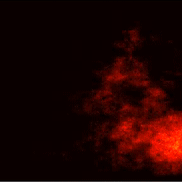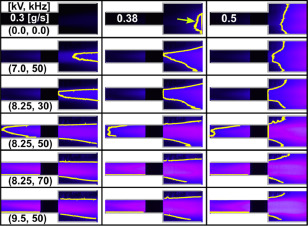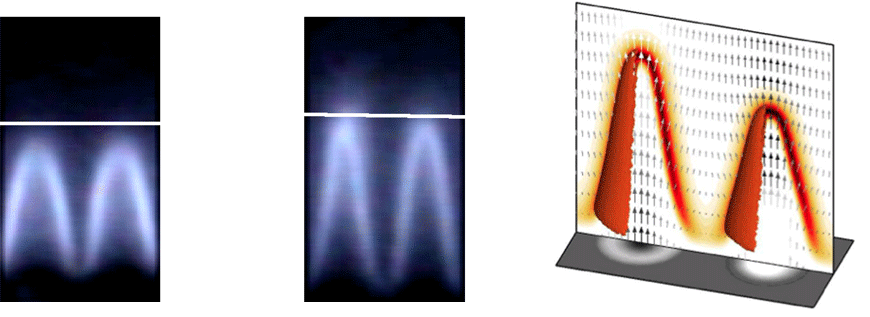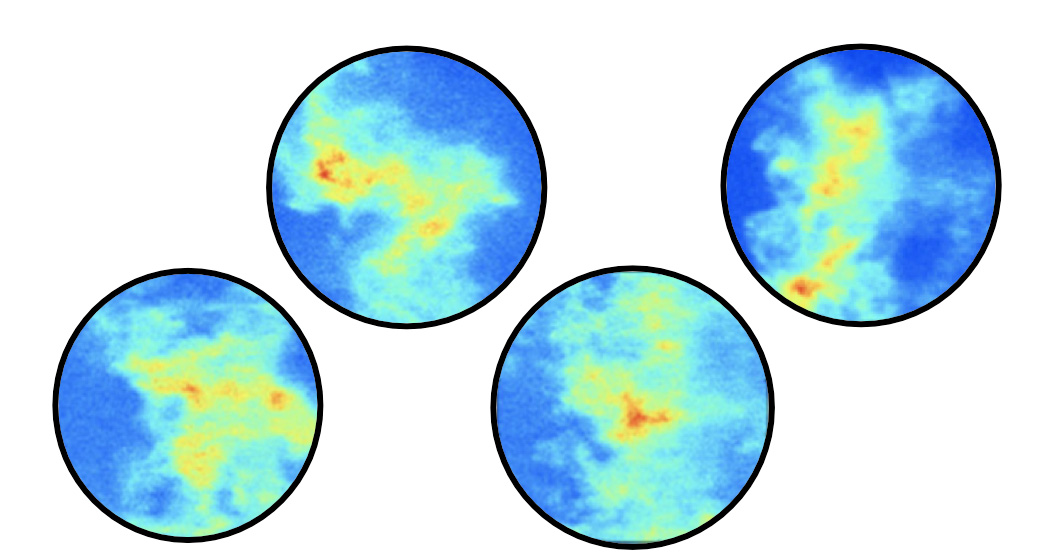Combustion
One of the main research area at CAPS is combustion. This research is driven by the pressing needs for sustainable combustion technologies in the energy and transport sectors for the many key applications that cannot be electrified. There are indeed many critical technologies which necessitate processes at very high temperature (e.g. metallurgy), or which require the high energy density of chemical fuels for energy storage constraints (e.g. long distance aviation).
In this context, the global challenge is twofold: enabling massive production of green synthetic fuels for fueling these sectors, and developing combustion technologies for these green fuels while ensuring ultra-low pollutant (NOx, CO, particles) emissions. We are deeply engaged in the latter ambitious task, which cannot materialize without significant advances at the fundamental level.
In this context, we investigate the physics of novel combustor concepts with a wide spectrum of modeling tools and experimental diagnostics. The latter include high-speed particle image velocimetry and planar laser-induced fluorescence, as well as emission and absorption spectroscopy techniques; the former encompass analytically reduced chemistry and Large-Eddy-Simulation solvers for compressible reacting flows.
The European Research Council has financed a flagship project at the lab (external page ERC Consolidator Grant TORCH), which aimed at understanding and controlling thermoacoustic instabilities in new sequential gas turbine combustors. Another flagship project is the external page ERC Synergy Grant HYROPE, which aims at new fundamental understanding of the combustion physics of hydrogen at pressure. The motivation for this research is the envisioned clean combustion of sustainably produced hydrogen in large turbines, which will play a key role in stabilizing the electricity networks by balancing the intermittent production from the wind and solar sources.
Our research contributes to key technology development in aeronautics. For example, we contribute to the external page HYDEA project, which will demonstrate the feasibility of hydrogen propulsion on an aircraft engine in a compacted timeframe (2023-2026) up to the ground test. Indeed, although significant progress is being made in propelling light aircraft over short distances with electric motors, the electrification of long-haul flights, which cause most of the emissions and cannot be substituted by high-speed rail, appears technologically unrealistic in the next few decades. This is because the energy density of modern batteries, which does not increase more than a few percent per year, is about 50 times lower than that of kerosene. Therefore, without a viable alternative to combustion-based propulsion for long-haul flights, it is crucial to continue the research effort for decreasing pollutant emissions and enabling clean combustion of carbon-neutral synthetic fuels.
Publications

Numerical Study of Ignition and Combustion of Hydrogen-Enriched Methane in a Sequential Combustor
M.Impagnatiello, Q.Malé and N.Noiray
Flow, Turbulence and Combustion, Vol. 112, 2024
The ignition and combustion behavior in the second stage of a sequential combustor are numerically investigated at atmospheric pressure using Large Eddy Simulations (LES) for pure CH4 and two CH4-H2 fuel blends with mass ratios of 24:1 and 49:1, respectively. As the H2 content increases, the combustion dynamics undergo significant changes, characterized by the formation of multiple autoignition kernels upstream of the main flame front. This behavior is promoted by the large mass fraction of OH radicals in the flow entering the second stage, which is approximately an order of magnitude higher than that at chemical equilibrium and substantially enhances autoignition. [...]


Numerical study of nitrogen oxides chemistry during plasma assisted combustion in a sequential combustor
Q. Malé, N. Barléon, S. Shcherbanev, B. Dharmaputra and N. Noiray
Combustion and Flame, Vol. 260, 2024
Plasma Assisted Combustion (PAC) is a promising technology to enhance the combustion of lean mixtures prone to instabilities and flame blow-off. Although many PAC experiments demonstrated combustion enhancement, several studies report an increase in NOx emissions. The aim of this study is to determine the kinetic pathways leading to NOx formation in the second stage of a sequential combustor assisted by Nanosecond Repetitively Pulsed Discharges (NRPDs). For this purpose, Large Eddy Simulation (LES) associated with an accurate description of the combustion/NOx chemistry and a phenomenological model of the plasma kinetics is used. [...]


Air-blast atomization and ignition of a kerosene spray in hot vitiated crossflow
L. Miniero, K. Pandey, D. Fredrich, S. Shcherbanev, U. Doll, A. Giusti and N. Noiray
Combustion and Flame, Vol. 256, 2023
Promising concepts based on moderate or intense low-oxygen dilution (MILD) combustion have been investigated in academia and industry. This MILD regime can be obtained from the recirculation of the hot vitiated combustion products to raise the temperature of the reactants, resulting in distributed reaction regions and lower flame temperatures. In the present work, we consider the air-blast atomization of a kerosene spray in crossflow, which enables efficient mixing between fuel and oxidizer [...]


Confined Boundary-Layer Flashback Flame Dynamics in a Turbulent Swirling Flow
A. G. Novoselov, D. Ebi and N. Noiray
AIAA Journal, 2023
Understanding boundary-layer flashback is critical to the design of safe and efficient gas turbines, especially as the addition of highly reactive hydrogen to these devices becomes a prevailing trend for reduction of carbon dioxide emissions. In this work, the boundary-layer flashback of lean hydrogen–air mixtures is studied using large-eddy simulations based on a generic turbulent swirl burner previously investigated experimentally. [...]


Accurate Prediction of Confined Turbulent Boundary Layer Flashback Through a Critically Strained Flame Model
A. G. Novoselov, D. Ebi and N. Noiray
Journal of Engineering for Gas Turbines and Power, Vol. 144, 2022
A novel boundary layer flashback model is developed based on previous measurements that showed flashback limits may be related to strained premixed flame extinction. According to the model, flashback occurs at the equivalence ratio where the strained extinction limit flame speed matches the mean axial flow velocity one thermal distance from the wall. The model is validated by comparison with experimental measurements of flashback of confined nonswirling turbulent hydrogen-air flames. [...]


Effect of plasma-flow coupling on the ignition enhancement with non-equilibrium plasma in a sequential combustor
S. A. Shcherbanev, Q. Malé, B. Dharmaputra, R. Solana-Pérez and N. Noiray
Journal of Physics D: Applied Physics, Vol. 55, 2022
The effect of the regime of nanosecond repetitively pulsed discharges (NRPDs) on ignition and stabilization of a natural-gas/hydrogen/air flame in the sequential stage of a lab-scale atmospheric pressure sequential combustor is investigated experimentally. Electrical parameters of the NRPDs are characterized by measuring voltage, current, and deposited energy. Fast gas heating (FGH) of the nanosecond discharges is measured in a single pulse regime and validated by means of 0D kinetic modelling. [...]


Large Eddy Simulation of a Reacting Kerosene Spray in Hot Vitiated Cross-Flow
Daniel Fredrich, Luigi Miniero, Khushboo Pandey, William P. Jones, Nicolas Noiray & Andrea Giusti
Flow, Turbulence and Combustion, Vol. 109, 2022
The evaporation and combustion characteristics of a kerosene spray injected perpendicularly into a cross-flow of high-temperature vitiated air is investigated. This fundamental flow configuration has wider implications for the future development of ultra-low emission aeronautical combustors, particularly with respect to technologies involving MILD combustion. Large eddy simulations with a Eulerian–Lagrangian framework are performed to investigate the spray evolution and the characteristics of the reaction zone for a range of conditions. [...]


Topological transitions of Jet A-1 lean azimuthal flames (LEAF)
K. Pandey, L. Miniero, U. Doll, P. M. de Oliveira, E. Mastorakos and N. Noiray
Proceedings of the Combustion Institute, Vol. 39, 2022
Prior studies about liquid fuel combustion in a vitiated air environment have shown increased combustion efficiency with reduced NOx, CO, and soot emissions. The concept of lean azimuthal flame (LEAF), which can be associated to the latter combustion mode, is based on opposed injections of air and liquid fuel sprays in an axisymmetric chamber with a central outlet, which can result in a highly turbulent toroidal reaction zone. The present paper deals with a LEAF combustor with air-assisted spray atomization, which has not been investigated so far. [...]


Numerical study of plasma assisted combustion in a sequential combustor
Q. Malé, S. A. Shcherbanev and N. Noiray
Proceedings of the Combustion Institute, Vol. 39, 2022
The effects of Nanosecond Repetitively Pulsed Discharges (NRPDs) on the second stage flame of a sequential combustor is investigated using numerical tools supported by experiments. In this work, Large Eddy Simulations (LESs) with an accurate description of the combustion chemistry and a simplified model of the plasma kinetics are performed and successfully reproduce experimental observations of the combustion enhancement obtained with NRPDs. [...]


Combustion regime transition of H2 flames during steady and transient operation of a sequential combustor
R. Solana-Pérez, S. A. Shcherbanev, B. Dharmaputra, A. Ciani and N. Noiray
Proceedings of the Combustion Institute, Vol. 39, 2022
The combustion regime transition in a sequential burner (SB) supplied with H2 (48 kW) is experimentally studied during steady and transient operation. The test rig is a simplified model of an industrial sequential combustor featuring two-staged combustion chambers separated by a mixing section in which dilution air and fuel are injected. The temperature, velocity and composition of the hot vitiated gas flowing through the SB are defined by the products from the first stage (30 kW natural gas-air flame at equivalence ratio 0.7), and by the mass flow of dilution air. [...]


Soot-free and low-NO combustion of Jet A-1 in a lean azimuthal flame (LEAF) combustor with hydrogen injection
L. Miniero, K. Pandey, G. De Falco, A. D’Anna and N. Noiray
Proceedings of the Combustion Institute, Vol. 39, 2022
The quest for aeroengine technologies capable of reducing soot and NOx emissions motivates the development of novel burner concepts. The present work contributes to this line of research by presenting and characterizing a low emissions LEAF combustor fuelled with Jet A-1 and hydrogen at atmospheric condition. [...]


Simulation of the Self-Ignition of a Cold Premixed Ethylene-Air Jet in Hot Vitiated Crossflow
R. Solana-Pérez, O. Schulz, N. Noiray
Flow, Turbulence and Combustion, Vol. 106, 2021
The aim of this paper is to analyze the self-ignition of a jet flame in hot vitiated cross flow using Large Eddy Simulation with analytically reduced chemistry. A rich premixed ethylene-air mixture at 300 K is injected into a hot vitiated crossflow at 1500 K. The simulated reacting flow steady-state was validated against experiments in previous publications and the focus of the present work is the transient self-ignition of the jet. [...]


Morphology and Dynamics of a Premixed Hydrogen-Methane-Air Jet Flame in Hot Vitiated Turbulent Crossflow
R. Solana-Pérez, L. Miniero, S. Shcherbanev, M. Bothien, N. Noiray
Proceedings of the ASME Turbo Expo, 2021
The effect of hydrogen enrichment of a premixed hydrogen-methane-air jet in hot vitiated crossflow was studied at atmospheric condition. The hot turbulent vitiated crossflow is generated by a symmetric array of 4x4 jet flames burning a lean mixture of natural gas and air in fully premixed condition at equivalence ratio 0.7 and total thermal power of 50 kW. This crossflow is then used to ignite the premixed perpendicular jet of hydrogen-methane-air at ambient temperature. [...]


Anchoring of premixed jet flames in vitiated crossflow with pulsed nanosecond spark discharge
S. Shcherbanev, T. Morinière, R. Solana Pérez, M. Weilenmann, Y. Xiong, U. Doll and N. Noiray
Applications in Energy and Combustion Science, Vol. 1-4, 2020
This paper deals with the effect of non-equilibrium plasma on the anchoring of a premixed jet flame in hot vitiated crossflow at atmospheric pressure. The turbulent vitiated crossflow was generated by an array of 4×4 premixed turbulent jet flames burning a lean mixture of air and natural gas at an equivalence ratio of 0.7 and a thermal power of 50 kW. [...]


Combustion regimes in sequential combustors: Flame propagation and autoignition at elevated temperature and pressure
O. Schulz and N. Noiray
Combustion and Flame, Vol. 205, 2019
This numerical study investigates the combustion modes in the second stage of a sequential combustor (partially-premixed) at atmospheric and high pressure. First, combustion regime maps are obtained from 0-D and 1-D simulations showing the co-existence of three combustion modes: autoignition, flame propagation and flame propagation assisted by autoignition. [...]


Autoignition-cascade in the windward mixing layer of a premixed jet in hot vitiated crossflow
O. Schulz, E. Piccoli, A. Felden, G. Staffelbach and N. Noiray
Combustion and Flame, Vol. 201, 2019
This study focuses on the flame stabilization mechanism of a reactive jet in crossflow (premixed ethylene-air jet injected into a hot vitiated crossflow). A 3-D LES gives access to the spatio-temporal evolution of the autoignition process along the windward mixing layer and the a chemical explosive mode analysis shows that autoignition is the dominant flame stabilization mechanism on the windward side of the jet. [...]


Large eddy simulation of a premixed flame in hot vitiated crossflow with analytically reduced chemistry
O. Schulz, N. Noiray
Journal of Engineering for Gas Turbines and Power, Vol. 141, 2018
This numerical study deals with a premixed ethylene-air jet at 300 K injected into a hot vitiated crossflow at 1500 K and atmospheric pressure. The reactive jet in crossflow (RJICF) was simulated with compressible 3-D large eddy simulations (LES) with an analytically reduced chemistry (ARC) mechanism and the dynamic thickened flame (DTF) model. ARC enables simulations of mixed combustion modes, such as autoignition and flame propagation, that are both present in this RJICF.


Ignition of a sequential combustor: Evidence of flame propagation in the autoignitable mixture
D. Ebi, U. Doll, O. Schulz, Y. Xiong and N. Noiray
Proceedings of the Combustion Institute, Vol. 37, 2019
Ignition of the second stage in a lab-scale sequential combustor is investigated experimentally. A fuel mixing section between jet-in-cross-flow injection and the second stage chamber allows the fuel and vitiated, hot cross-flow to partially mix upstream of the main heat release zone. The focus of the present work is on the transient ignition process leading to a stable flame in the second stage. [...]


Plasma enhanced auto-ignition in a sequential combustor
Y. Xiong, O. Schulz, C. Bourquard, M. Weilenmann and N. Noiray
Proceedings of the Combustion Institute, Vol. 37, 2019
To control the ignition and stabilization location of the second stage flame in a sequential combustor, nanosecond repetitively pulsed discharges (NRPD) were generated between three cylindrical electrodes. The NRPD were obtained by repetitively applying high voltage pulses to the central electrode. [...]


Autoignition flame dynamics in sequential combustors
O. Schulz and N. Noiray
Combustion and Flame, Vol. 192, 2018
This numerical study investigates the linear and non-linear flame dynamics in the second stage of a sequential combustor, with methane fuel injection into vitiated hot gas. It focuses on the heat release rate response of the sequential flame to entropy waves. The response is shown to be very sensitive to small changes in operating condition and excitation amplitude. [...]


A criterion to distinguish autoignition and propagation applied to a lifted methane–air jet flame
O. Schulz, T. Jaravel, T. Poinsot, B. Cuenot and N. Noiray
Proceedings of the Combustion Institute, Vol. 36, 2017
This numerical study employs state-of-the-art numerical tools to investigate the flame stabilisation mechanism of a methane/air jet into a hot vitiated coflow at 1350K (the Cabra flame). Autoignition chemistry is initialized in very lean mixtures upstream of the actual flame base, and is identified as the main flame stabilization mechanism.

Dynamic phase converters

Autoignition stabilized flames
